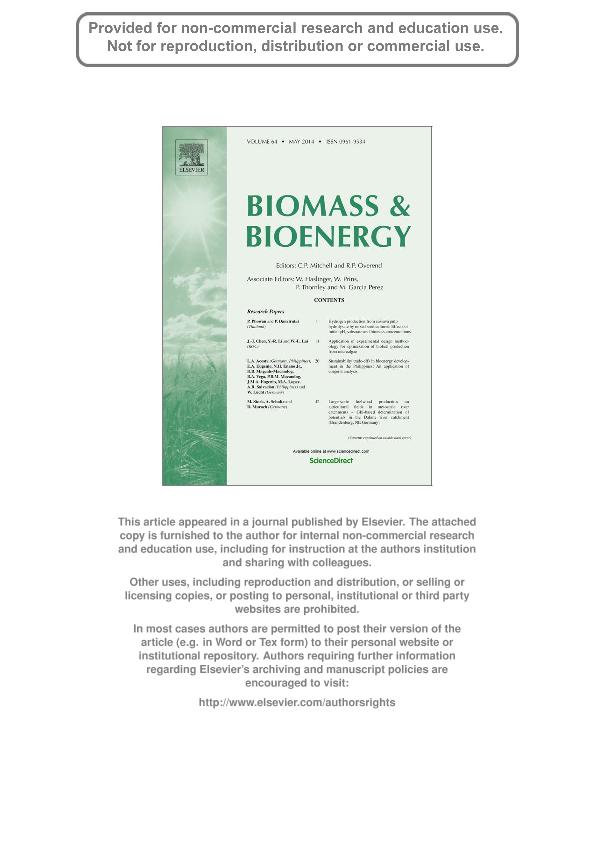Mostrar el registro sencillo del ítem
dc.contributor.author
Falasca, Silvia Liliana

dc.contributor.author
Ulberich, Ana Cristina

dc.contributor.author
Pitta Alvarez, Sandra Irene

dc.date.available
2018-01-11T19:21:56Z
dc.date.issued
2014-04
dc.identifier.citation
Falasca, Silvia Liliana; Pitta Alvarez, Sandra Irene; Ulberich, Ana Cristina; Possibilities for growing kenaf (Hibiscus cannabinus L) in Argentina as biomass feedstock under dry-subhumid and semiarid climate conditions; Elsevier; Biomass and Bioenergy; 64; 4-2014; 70-80
dc.identifier.issn
0961-9534
dc.identifier.uri
http://hdl.handle.net/11336/33018
dc.description.abstract
Kenaf (Hibiscus cannabinus L.) is an annual herbaceous crop with a high biomass production. In this paper, and based on international bibliography, the authors outline an agro-climatic and agro-ecological zoning model to determine potential growing areas in Argentina for kenaf. The bioclimatic variables considered were: 150 frost-free days, isohyets of 500, 780 and 1200 mm corresponding to November–March (the growing period), a mean annual temperature of 11.5 °C and temperatures of 15 °C, 20 °C, 25 °C and 27 °C during the growing period. The agroclimatic indices, which determine different classes of suitability, were integrated in a Geographic Information System in order to create thermic and hydric regions. The maps were superimposed, and the overlapping regions delineated the agroclimatic zoning. Thornthwaite's Moisture Index = 0 was overlapped on the agroclimatic zoning map to guarantee that the lands to be occupied by the proposed energy crop would be located under dry-subhumid, semiarid or arid climate conditions. This last map was superimposed on another one that determined unsuitable soils for traditional agriculture. The overlapping regions defined the agro-ecological zoning for kenaf. This is an innovative work, made by the implementation of a geographic information system that can be updated by the further incorporation of complementary information, with the consequent improvement of the original database. Furthermore, its focus is not merely local since the model described may be applied to any part of the world, using the agroclimatic limits presented in this paper.
dc.format
application/pdf
dc.language.iso
eng
dc.publisher
Elsevier

dc.rights
info:eu-repo/semantics/openAccess
dc.rights.uri
https://creativecommons.org/licenses/by-nc-sa/2.5/ar/
dc.subject
Kenaf
dc.subject
Bioclimatic Requirements
dc.subject
Agroclimatic Zoning
dc.subject
Agro-Ecological Zoning
dc.subject
Biomass Crop
dc.subject
Argentina
dc.subject.classification
Meteorología y Ciencias Atmosféricas

dc.subject.classification
Ciencias de la Tierra y relacionadas con el Medio Ambiente

dc.subject.classification
CIENCIAS NATURALES Y EXACTAS

dc.title
Possibilities for growing kenaf (Hibiscus cannabinus L) in Argentina as biomass feedstock under dry-subhumid and semiarid climate conditions
dc.type
info:eu-repo/semantics/article
dc.type
info:ar-repo/semantics/artículo
dc.type
info:eu-repo/semantics/publishedVersion
dc.date.updated
2018-01-11T13:48:02Z
dc.journal.volume
64
dc.journal.pagination
70-80
dc.journal.pais
Países Bajos

dc.journal.ciudad
Ámsterdam
dc.description.fil
Fil: Falasca, Silvia Liliana. Instituto Nacional de Tecnología Agropecuaria. Centro de Investigación de Recursos Naturales. Instituto de Clima y Agua; Argentina. Consejo Nacional de Investigaciones Científicas y Técnicas; Argentina
dc.description.fil
Fil: Ulberich, Ana Cristina. Consejo Nacional de Investigaciones Científicas y Técnicas; Argentina. Universidad Nacional del Centro de la Provincia de Buenos Aires. Facultad de Ciencias Humanas. Departamento de Ciencias Ambientales. Centro de Investigación y Estudios Ambientales; Argentina
dc.description.fil
Fil: Pitta Alvarez, Sandra Irene. Universidad Argentina de la Empresa; Argentina. Consejo Nacional de Investigaciones Científicas y Técnicas; Argentina
dc.journal.title
Biomass and Bioenergy

dc.relation.alternativeid
info:eu-repo/semantics/altIdentifier/url/https://www.sciencedirect.com/science/article/pii/S0961953414001494
dc.relation.alternativeid
info:eu-repo/semantics/altIdentifier/doi/http://dx.doi.org/10.1016/j.biombioe.2014.03.031
Archivos asociados
